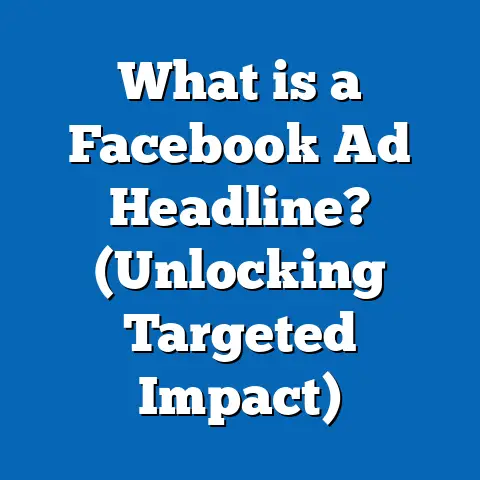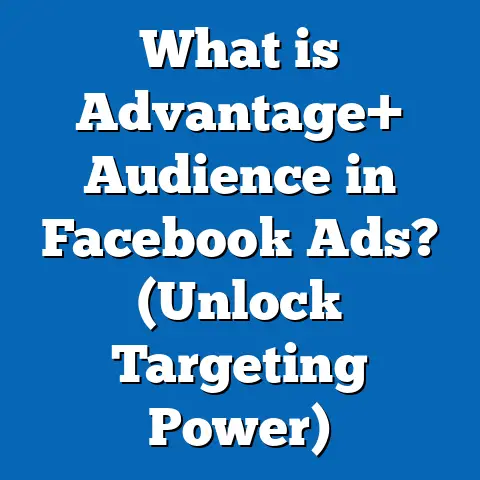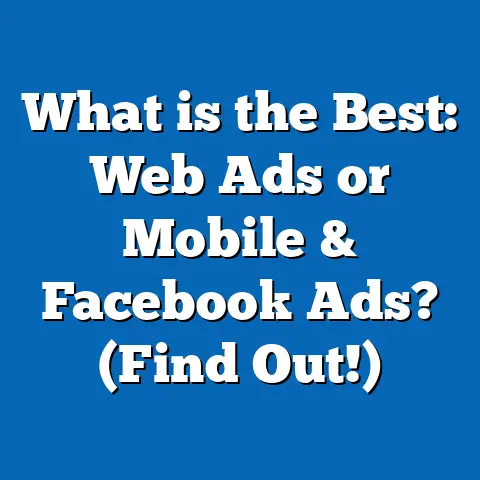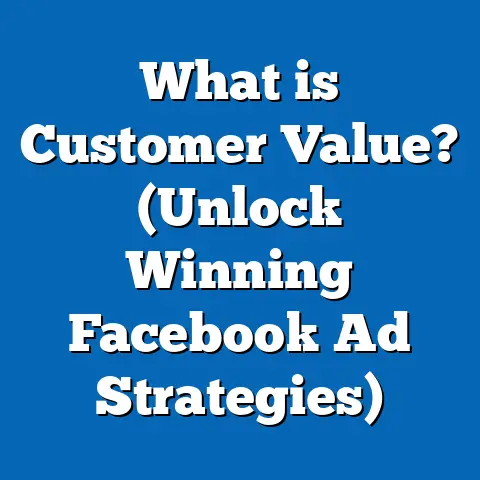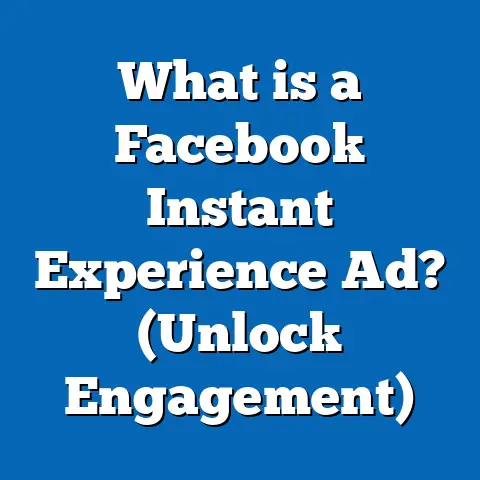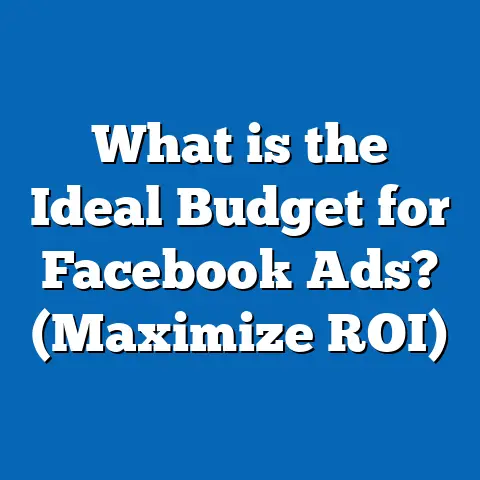What is a Good Facebook Ad Click-Through Rate? (Maximize Results!)
What is a Good Facebook Ad Click-Through Rate? (Maximize Results!)
Introduction: Why Facebook Ad Click-Through Rate Matters More Than Ever
Imagine you’ve invested heavily in a Facebook ad campaign. You’ve crafted perfect visuals, written compelling copy, and targeted what you thought was the ideal audience. But the results? Disappointing. Few clicks, minimal engagement, and negligible conversions. It stings because every dollar spent feels wasted.
This frustration is common but avoidable. The click-through rate (CTR) is your clearest indicator of whether your ads are actually connecting with your audience. It’s the pulse of your campaign—a direct measure of interest and relevance.
CTR doesn’t just tell you how many people click; it reveals the emotional and cognitive response to your messaging. If your CTR is low, it means your ad isn’t sparking enough curiosity or need. If it’s high, your ad is resonating deeply.
In today’s competitive digital environment, understanding what makes a “good” Facebook ad CTR is vital. It’s about turning impressions into meaningful engagement and ultimately driving business growth. This guide breaks down everything you need to know—from fundamentals to advanced tactics—to maximize your Facebook advertising results.
Understanding Facebook Ad Click-Through Rate (CTR)
What is Click-Through Rate?
Click-through rate (CTR) is a metric that represents the percentage of people who clicked on an ad after seeing it. It’s calculated as: CTR=(Number of ClicksNumber of Impressions)×100\text{CTR} = \left( \frac{\text{Number of Clicks}}{\text{Number of Impressions}} \right) \times 100
For example, if your ad was seen 10,000 times and received 300 clicks, your CTR is: CTR=(30010,000)×100=3%\text{CTR} = \left( \frac{300}{10,000} \right) \times 100 = 3\%
This percentage gives marketers a quick snapshot of ad relevance and effectiveness.
Why CTR Is a Crucial Metric in Facebook Advertising
CTR serves multiple key purposes:
- Gauge Ad Relevance: A higher CTR means your ad appeals well to your audience’s interests or needs.
- Lower Costs: Facebook rewards ads with higher CTRs by lowering cost per click (CPC), improving budget efficiency.
- Improve Algorithmic Delivery: Facebook’s algorithm favors ads with strong engagement metrics, pushing them to more relevant users.
- Predict Campaign Success: While not the only metric, CTR is often an early indicator of how well your campaign will perform against business goals like sales or sign-ups.
Common Misconceptions About CTR
- “High CTR always equals success.” Not always. Sometimes clicks don’t convert into leads or sales.
- “CTR is the only metric that matters.” It should be considered alongside conversion rate, CPC, ROAS (Return on Ad Spend), and other KPIs.
- “More impressions mean better results.” If impressions aren’t from a targeted audience, CTR will suffer.
Understanding these nuances helps marketers interpret CTR in context.
What is a Good Facebook Ad Click-Through Rate?
Industry Benchmarks for Facebook Ad CTR
Facebook ads cover diverse industries with different user behaviors and competition levels. Industry-specific benchmarks provide a useful starting point for what to expect.
Here’s an updated breakdown based on recent data from WordStream (2023) and other sources:
| Industry | Average CTR (%) | Notes |
|---|---|---|
| Apparel | 1.24% | Visual-heavy industry; creative quality impacts CTR heavily |
| Automotive | 0.89% | Niche targeting critical due to high purchase price |
| B2B | 0.78% | Often lower CTR due to complex decision-making process |
| Consumer Services | 0.90% | Service ads often require strong trust signals |
| Education | 0.73% | Needs compelling reasons for sign-ups |
| Finance | 0.56% | Highly regulated ads often see lower engagement |
| Healthcare | 0.83% | Sensitive topics require careful messaging |
| Retail | 1.59% | Strong visual appeal and promotions boost CTR |
| Technology | 1.04% | Innovation interest drives clicks |
What Counts as a “Good” CTR?
While benchmarks provide guidance, “good” is relative to your goals and context:
- Below 1%: Typically signals underperforming ads that need review.
- 1% to 3%: Solid performance; indicates decent audience alignment and creative.
- Above 3%: Excellent; usually means highly relevant and compelling ads.
For small businesses or niche markets, even a 0.5%-1% CTR may be acceptable depending on cost efficiency.
Factors That Influence Facebook Ad CTR
Audience Targeting: The Foundation of High CTR
Precise targeting ensures ads reach people most likely to engage.
Types of Targeting:
- Demographics: Age, gender, location, language.
- Interests & Behaviors: Hobbies, online behavior patterns.
- Custom Audiences: Based on your own data like website visitors or email subscribers.
- Lookalike Audiences: New users similar to your best customers.
- Exclusion Targeting: Removing irrelevant users to increase relevance.
Example: An online fitness brand increased CTR by 40% after excluding users already subscribed to their newsletter, focusing budget on new prospects.
Ad Creative Quality: Capturing Attention Instantly
Ad creative is how you communicate value and prompt action.
- Visuals: Use clear, vibrant images or videos that relate directly to your offer.
- Copy: Headlines should be concise and benefit-driven.
- Call-to-Action (CTA): Use direct CTAs like “Shop Now,” “Learn More,” or “Get Started.”
- Emotional Hooks: Use stories, urgency (“limited time”), or exclusivity (“members only”) to motivate clicks.
Example: A travel company saw its video ad’s CTR rise from 1.2% to 2.8% after swapping static images for immersive destination clips with upbeat music and dynamic text overlays.
Ad Placement: Where Your Ad Lives Affects Its Performance
Facebook offers multiple placements including:
- Feeds (Desktop & Mobile): Most common and generally highest CTR.
- Stories: Full-screen vertical ads; effective for mobile-first users.
- Right Column: Less intrusive but tends to have lower CTR.
- Audience Network: Extends reach outside Facebook apps.
Placement choice affects visibility and engagement rates. Testing multiple placements helps identify best performing spots.
Campaign Objective Alignment
Facebook optimizes ad delivery based on selected campaign objectives:
- Traffic Objective: Prioritizes clicks to website or landing pages—usually highest CTR.
- Conversions Objective: Focus on actions like purchases; may sacrifice some CTR for quality traffic.
- Brand Awareness / Reach: Aims for impressions over clicks; CTR can be lower but awareness grows.
Choosing the right objective ensures alignment between ad delivery and desired behavior.
Case Studies: Real-Life Examples of Improving Facebook Ad CTR
Case Study 1: E-commerce Brand Boosts CTR Through Audience Refinement
A mid-sized eco-friendly products retailer ran two campaigns side by side:
- Campaign A: Broad targeting based on generic interests (e.g., “environment,” “organic”).
- Campaign B: Narrow targeting using Custom Audiences from website visitors plus Lookalike Audiences based on past purchasers.
Results after one month:
| Metric | Campaign A | Campaign B |
|---|---|---|
| Impressions | 100,000 | 80,000 |
| Clicks | 800 | 2,000 |
| CTR | 0.8% | 2.5% |
| CPC | $1.20 | $0.75 |
Campaign B achieved a 150% increase in CTR with a 37% lower CPC by focusing budget on warm and lookalike audiences.
Case Study 2: SaaS Company Uses Video Ads to Raise CTR by 60%
A SaaS company struggled with low engagement on static ads promoting their new software feature.
They tested:
- Static image ads featuring screenshots vs.
- Short explainer videos highlighting benefits and user testimonials.
Results over two weeks:
| Metric | Static Image Ads | Video Ads |
|---|---|---|
| Impressions | 50,000 | 50,000 |
| Clicks | 350 | 560 |
| CTR | 0.7% | 1.12% |
| Conversion Rate | 12% | 15% |
Video ads increased click-through rate by over 60%, also improving conversions due to clearer messaging.
How to Improve Your Facebook Ad CTR: Step-by-Step Guide
Step 1: Refine Your Audience Targeting
- Build Custom Audiences from high-value users like repeat buyers or engaged website visitors.
- Create Lookalike Audiences based on these groups for efficient scaling.
- Exclude irrelevant users who won’t engage (e.g., current customers if promoting new customer offers).
- Use demographic filters aligned with buyer personas.
Step 2: Optimize Your Ad Creatives
- Test multiple images/videos per campaign.
- Write headlines highlighting benefits over features.
- Use short descriptive text with emotional triggers.
- Implement clear CTAs tailored to campaign goals.
Example CTA variations: “Shop Today,” “Download Free Guide,” “Sign Up Now.”
Step 3: Experiment With Ad Formats and Placements
- Carousel ads allow showcasing multiple products or features in one ad.
- Stories ads are great for immersive mobile experiences.
- Video ads tend to outperform images but require production effort.
- Use automatic placements initially then refine based on performance data.
Step 4: Continuously Test and Analyze
- Run A/B tests for headlines, creatives, CTAs.
- Monitor metrics daily during campaigns.
- Pause underperforming ads quickly to reallocate budget.
Use Facebook Ads Manager’s breakdown reports to analyze performance by age, gender, placement, device.
Step 5: Align Landing Pages With Ads
High CTR alone isn’t enough if users bounce without converting.
Ensure landing pages:
- Load quickly (under 3 seconds).
- Match messaging and visuals from ads.
- Have clear action steps (buttons/forms).
A seamless experience increases overall campaign effectiveness.
Advanced Insights: Understanding Click Types and User Intent
Facebook tracks different types of clicks:
- Link Clicks: Direct clicks to external URLs (your website or app).
- Post Engagement Clicks: Interactions like likes/comments/shares that don’t lead off-platform.
- Other Clicks: Profile or page views not tied to direct traffic goals.
Focusing on link clicks provides a more accurate picture of traffic-driving effectiveness.
Why User Intent Matters
Not all clicks indicate readiness to buy or engage deeply. Some are accidental or out of curiosity.
Understanding intent allows better optimization:
- Use retargeting ads for users who clicked but didn’t convert.
- Tailor messaging based on user stage in sales funnel (awareness vs decision).
Comparing Facebook Ad CTR With Other Platforms
Facebook’s average CTR sits in the mid-range among digital advertising platforms:
| Platform | Average CTR (%) | Remarks |
|---|---|---|
| Google Search | ~3.17% | High intent; users actively searching |
| Google Display | ~0.46% | Lower intent visual ads on websites |
| Instagram Ads | ~0.58% | Visual platform; younger demographics |
| LinkedIn Ads | ~0.39% | B2B focus; higher cost per click |
| Twitter Ads | ~1.55% | Newsfeed-based; trending topics boost engagement |
Facebook’s advantage is its detailed targeting options and diverse creative formats allowing highly tailored campaigns.
The Role of Facebook’s Algorithm in Influencing CTR
Facebook uses machine learning algorithms that optimize ad delivery based on predicted engagement likelihood.
Ads with higher initial CTR:
- Get shown more frequently to relevant users.
- Benefit from lower CPC due to better Quality Scores.
Quality Score factors include:
- User feedback (positive/negative).
- Engagement rates (likes/comments/shares).
- Relevance Score (now part of broader “Ad Relevance Diagnostics”).
Understanding how the algorithm works helps marketers prioritize quality over quantity in ad creation.
Practical Example: Building a High-CTR Facebook Ad Campaign From Scratch
Scenario:
A new online course launch targeting young professionals interested in career development.
Steps:
- Objective: Traffic campaign driving sign-ups for free webinar introduction.
- Audience Targeting:
- Custom Audience from email list of previous webinar attendees.
- Lookalike Audience based on paying students.
- Age filter: 22–35 years old in English-speaking countries.
- Creative Development:
- Short video explaining course benefits + student testimonials.
- Carousel ad showing course modules & success stories.
- Ad Copy:
- Headline variants like “Boost Your Career Fast” vs “Learn In-Demand Skills Today.”
- CTA buttons like “Register Now” and “Join Free Webinar.”
- Placement:
- Feed (desktop + mobile), Stories for mobile-first reach.
- Testing & Optimization:
- Run A/B tests on headlines and creative formats.
- Monitor CTR & conversion daily; pause low performers promptly.
Outcome after first month:
| Metric | Result |
|---|---|
| Average CTR | 3.5% |
| Webinar Sign-Ups | Increased by 40% |
| Cost per Sign-Up | $8 |
The high CTR showed strong interest driven by precise targeting and engaging creative aligned with user needs.
Common Pitfalls That Lead to Low Facebook Ad CTR
Mistake #1: Broad Targeting Without Segmentation
Reaching everyone means reaching no one effectively—ads lose relevance resulting in low engagement.
Mistake #2: Weak or Confusing Messaging
Ads lacking clear benefits or CTAs confuse users rather than inspire action.
Mistake #3: Ignoring Mobile Optimization
More than 90% of Facebook users access via mobile devices —ads not optimized for mobile visuals suffer drastically reduced CTR.
Mistake #4: Not Testing Creatives Regularly
Sticking with one version reduces chances of discovering higher-performing combinations.
Mistake #5: Irrelevant Landing Pages
Disconnect between ad promise and landing page content causes user drop-off even after clicking.
Latest Trends Impacting Facebook Ad Click-Through Rates (2024)
Short-form Video Dominance
Videos under 15 seconds have surged in popularity due to TikTok influence and user attention spans shrinking. These quick videos generate higher engagement than static images or longer videos.
Privacy & Tracking Changes
Apple’s iOS privacy updates (App Tracking Transparency) have limited tracking capabilities affecting retargeting accuracy and attribution models—advertisers must adapt strategies accordingly by emphasizing first-party data collection and broad audience targeting combined with conversion modeling.
AI-Powered Creative Tools
Facebook’s integration of AI tools in Ads Manager can auto-generate personalized creatives at scale improving relevance and potentially boosting CTR through dynamic content adjustments.
Interactive & Immersive Ads
New formats like Poll Ads or Instant Experience Ads encourage active participation rather than passive viewing, driving better engagement rates including higher CTRs.
Deep Dive: Measuring Beyond CTR—What Else Matters?
CTR is important but must be balanced with other KPIs:
- Conversion Rate: Percentage of clicks converting into desired actions (purchases/signups).
- Cost Per Click (CPC): How much you pay on average per click; lower CPC means more efficient spending.
- Return on Ad Spend (ROAS): Revenue generated per dollar spent on ads; ultimate profitability measure.
- Engagement Metrics: Likes/shares/comments signaling brand affinity even if not direct clicks.
- Frequency: Number of times an individual sees an ad; too high frequency may cause ad fatigue reducing CTR over time.
Understanding the interplay helps optimize entire funnel performance rather than chasing high CTR alone.
Additional Case Study: Non-Profit Organization Boosts Donations Through Optimized Facebook Ads
A non-profit aiming to increase donations for wildlife conservation refined their ad approach:
- Targeted donors interested in environmental causes using detailed interest filters.
- Used emotional video storytelling highlighting endangered species plight.
- Added strong CTA “Donate Now – Save Their Future.”
Results after three months:
| Metric | Before Optimization | After Optimization |
|---|---|---|
| Impressions | 150,000 | 120,000 |
| Clicks | 900 | 3,600 |
| CTR | 0.6% | 3.0% |
| Donation Rate | 4% | 7% |
The quadrupled CTR contributed directly to a nearly doubled donation conversion rate demonstrating the power of targeted emotional creative combined with precise audience selection.
Summary: Key Takeaways on Good Facebook Ad Click-Through Rate
- A good Facebook ad CTR depends heavily on industry norms but generally falls between 1% and 3%, with anything above considered excellent.
- High CTR signals effective targeting and compelling creatives but must be evaluated alongside conversion metrics for true success measurement.
- Precise audience segmentation including Custom and Lookalike Audiences dramatically improves relevance and engagement rates.
- Creative quality—visuals, copywriting, CTA strength—is crucial in capturing attention quickly within busy feeds.
- Proper placement selection tailored to mobile or desktop can influence results significantly.
- Continuous testing combined with monitoring algorithmic feedback optimizes campaigns dynamically.
- Current trends such as short-form video content, AI-driven personalization, privacy impacts, and interactive formats should be leveraged strategically for maximum impact.
Next Steps: Maximizing Your Facebook Ad Performance
- Review current campaigns focusing on detailed segmentation beyond basic demographics.
- Refresh creatives regularly using video where possible emphasizing emotional connection and clear CTAs.
- Test multiple formats including carousel, stories, and interactive ads to find best fit for your audience.
- Align landing pages tightly with ad messaging ensuring fast load times and clear next steps.
- Monitor not just CTR but conversion rates and cost efficiency daily adjusting budgets accordingly.
- Use AI tools available in Facebook Ads Manager for dynamic creative optimization when applicable.
- Plan for privacy changes by prioritizing first-party data collection and diversification of targeting strategies.
By mastering these elements around click-through rate optimization, you unlock stronger campaign results leading to improved ROI and sustained business growth through Facebook advertising.

